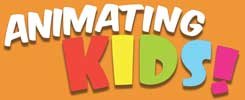Step into stop motion storytelling and cement learning in students minds for a lifetime.
It has been our honor to be the hero's guide on many a storytelling quest. The fun and learning are contagious and these young media mavens arrive at their destination with a film they can share with the world.
As a teacher, one of the most rewarding experiences is seeing your students engaged and excited about learning. There's nothing quite like the energy in the classroom when a group of kids are working on a stop motion animation.
One student response stands out in sharp relief in my memory because it encapsulated everything right about this thrilling form of education.
It was several years ago in the Bronx in a 4th grade classroom. I was a visiting animator. I remember the young animators were bringing a hydrogen and an oxygen atom together in an animation about atomic bonds. The students were using coffee straws and globs of clay to represent the bonds and the atoms, and they had given them googly-eyes and lips to make them more relatable.
Instead of simply reading about a chemical bond in a textbook, the kids were actively creating an animated short film about the concept. This not only makes the material more engaging, but it also helps kids to better understand and remember the information.
In this case, they had created a story idea about a dating app for the periodic chart elements. I think it was called Periodic Pals, or Molecular Mates or Combine or something of the sort. Hilarious! Framing the periodic elements as potential dating companions gave them a chance to think about dialogue: what pick-up lines they would use, where they would hang out to meet, etc. They had sequenced the scenes on a storyboard.
I overheard one of the students joke to his group, "I never knew atoms could be so attractive!" as he batted his eyelids in a lovey-dovey way. They were clearly having fun with idea of electron exchange and atomic bonding. And that's exactly what animation can do - it can make even the most complex concepts accessible and interesting material for their fertile, creative minds.
I asked, "Why are the atoms attracted to each other, besides love?" One of the students replied, "Because their electrons are bond.... Hey, wait! You are teaching us!" the student shouted, as if fun and learning were mutually exclusive. "Got me!" I said in a mock guilty tone and we all laughed. He thought he caught me quizzing them without their permission. He was right of course. I was seeing if they understood the underlying science. And they did. In fact they knew it so well they had built a romantic-comedy based on that science.
The sincerity in his voice and the shock that they might be gaining quizzible knowledge through animation was priceless. I've never forgotten it. They understood the science, but the storytelling, their particular brand of storytelling with sound and motion had taken things to a very fun place and they didn't want to be reminded that it was also learning.
Doesn't this blow your mind?
These kids get how relevant visual communication is to their lives. They are saturated in media as passive viewers outside school. As active creators and they can't wait to share their creation with the world, scientific or not. Their idols are media creators, and now they are an active participant in the process.
But wait, there's more!
They were developing critical thinking and problem-solving skills. They had to think about how to make the animation, what materials to use, and how to represent the concept in a creative way. They had to: defend their ideas, write narration and dialogue, engineer set designs, invent characters, and plot. They had to overcome each other's objections, and negotiate.
Life skills writ large, in service of science, storytelling and technology! Or maybe it is the other way around?
Next time you're struggling to make a concept come alive for your students, consider incorporating animation into your lesson plans. Trust me, you'll be amazed at the results. And if that sounds daunting, subscribe to Animating Kids, or at least show them any number of the hundreds of video on Youtube.
Just get started. We have seen tens of thousands of teachers and students become the heroes of their own film making journeys. You won't regret it.
We live in an amazing world.
Here's to giving kids media superpowers on their way to becoming the leaders of tomorrow.
Bon Animate!
Joe and the team at Animating Kids
Animating Kids table of content is here if you want to see our process.

